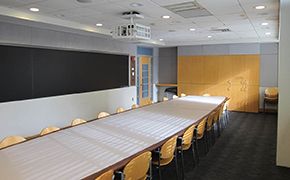Instructor Insights pages are part of the OCW Educator initiative, which seeks to enhance the value of OCW for educators.
So why #StayWoke for the course? Well, I love it because it’s one of these phrases that take a very complex concept and make it accessible to the larger public. (It’s) a way to talk about critical consciousness . . . (and) it means to be alert to the kind of propaganda that passes for history.
— Michel DeGraff
In the following videos, Professor Michel DeGraff describes various aspects of how he teaches 24.912 Black Matters: Introduction to Black Studies.
- An Interdisciplinary Approach
- Political Context for the Course
- Framing Cultural Phenomena as Technologies
- Anchoring the Course with #StayWoke
- Leveraging the Humanities to Break Walls and Build Bridges
- Advancing Social Justice
- Critical Computational Empowerment
- Building on the Personal
- Teaching a Wider Audience
- Unlocking Knowledge through MIT OpenCourseWare
Guest Speaker Insights
Any interchange with the world that will improve it, that will deal with the innumerable problems that exist, has to be based on an understanding of social, political, and economic realities—otherwise you can’t act in any serious way.
— Noam Chomsky
Professor Emeritus Noam Chomsky was a featured guest lecturer in 24.912 Black Matters: Introduction to Black Studies. Prior to facilitating a classroom discussion with students, he sat down with the OCW Educator Project Manager to share his insights about contemporary language issues and the value of the course materials for learners. The following videos capture excerpts of their conversation.
Student Insights
In order to be able to change the world, first we have to understand ourselves. (This course) helped me do a lot of that, such as navigating the tensions between how I am read and how I am, and trying to figure out those differences.
— Lorraine Wong, MIT Student
In the following videos, three students share insights about their experiences in 24.912 Black Matters: Introduction to Black Studies.
Curriculum Information
Prerequisites
None
Requirements Satisfied
HASS-A ![]()
HASS-H ![]()
CI-H ![]()
This course can be applied toward a Bachelor of Science in Women’s and Gender Studies, but is not required.
Offered
Every spring semester
Assessment
Grade Breakdown
The students' grades were based on the following activities:
Instructor Insights on Assessment
A rubric was used to assess student writing.
Student Information

Breakdown by Year
Mostly juniors and seniors, a few freshmen and sophomores
Breakdown by Major
Students were concentrating in a variety of majors.
Typical Student Background
A few students in the course were children of undocumented migrant workers. The sharing of their personal biographies enriched the course because it allowed students who had not had this experience to begin to deconstruct the notion of “illegal immigrants.” Through discussions with their peers, they came to understand that there are acts that are illegal, but that people cannot be illegal.
During an average week, students were expected to spend 12 hours on the course, roughly divided as follows:
In Class
- Met 2 times per week for 1.5 hours per session; 26 sessions total; mandatory attendance.
- Students participated in discussions and made presentations during class sessions. Sessions also included lectures from the instructor and other guests.
Out of Class
- Students prepared readings, wrote essays, and worked on their presentations outside of class.
Semester Breakdown
| WEEK | M | T | W | Th | F |
|---|---|---|---|---|---|
| 1 |  |  |  |  |  |
| 2 |  |  |  |  |  |
| 3 |  |  |  |  |  |
| 4 |  |  |  |  |  |
| 5 |  |  |  |  |  |
| 6 |  |  |  |  |  |
| 7 |  |  |  |  |  |
| 8 |  |  |  |  |  |
| 9 |  |  |  |  |  |
| 10 |  |  |  |  |  |
| 11 |  |  |  |  |  |
| 12 |  |  |  |  |  |
| 13 |  |  |  |  |  |
| 14 |  |  |  |  |  |
| 15 |  |  |  |  |  |
| 16 |  |  |  |  |  |
 No classes throughout MIT
No classes throughout MIT Class meeting
Class meeting Presentations
Presentations No class session scheduled
No class session scheduled Guest lecture
Guest lecture Due date
Due date

 Room 1 of 1
Room 1 of 1 
 15% Oral presentations
15% Oral presentations